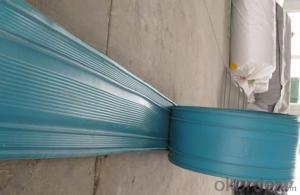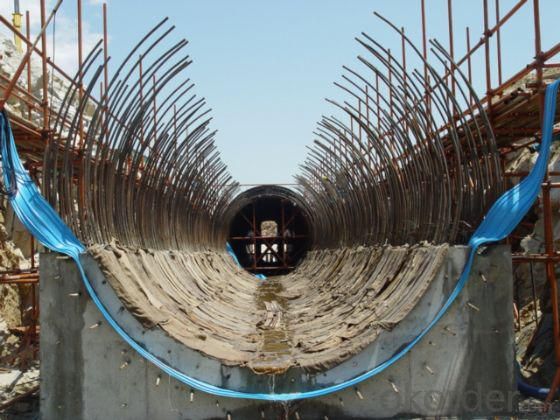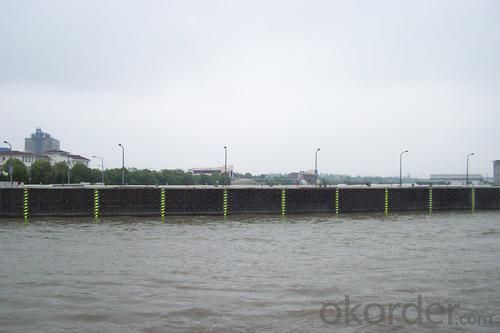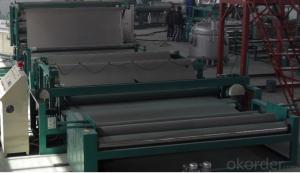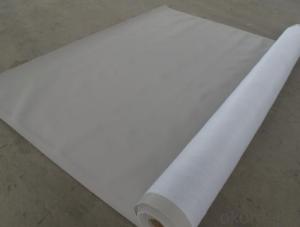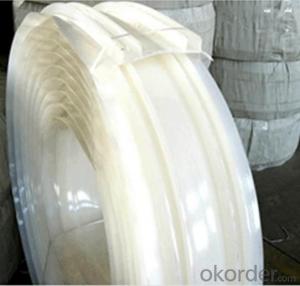PVC waterstops
- Loading Port:
- China Main Port
- Payment Terms:
- TT OR LC
- Min Order Qty:
- -
- Supply Capability:
- -
OKorder Service Pledge
OKorder Financial Service
You Might Also Like
Products Description
PVC,EVA waterstops is made of high grade polyvinyl chloride and features unique design and advanced
process. It is applicable for various joints during construction and use. Simple use and easy combination
in construction site.
Products Specification
Thickness :1.0-4 .0 mm
Width :15-30CM
Length: 20M
Features
● PVC, EVA waterstops for sealing construction and expansion joints of reinforced concrete (expansion joint),
placed in the concrete water stop, across and close the gap, forming a solid watertight seamless screen, to
prevent fluid flow through .
● PVC, EVA waterstops with a variety of different shapes, such as middle and external design, in any ground
or underground construction, the formation of a long and solid watertight network, especially for water and
retaining the the structure.
Physical Properties
Items |
| ||
Hardness(A) |
≥80±5 | ||
tensile strength MPa
|
≥13 | ||
Elongation,%
| ≥300% | ||
tear strength KN/m | ≥25 | ||
brittleness temperature ℃ |
≤-30 | ||
|
| ||
|
| ||
Installiton
PVC water stop rubber water stop with the same installation method. When buried in the poured concrete interface
to make it fit with the flat part of the adhesive fastening joints, buried in the process of pouring the power to appropriate
the full vibrating the concrete, making it a good combination with concrete, in order to obtain the best sealing effect .
Application Range
Different shapes of PVC,EVA Waterstops centrally and extermally placed allow lasting watertight seals in any grades
of construction design. They are typically used in water retaining and excluding structure, such as reservoirs, sewage tanks,
dams, pools, basements,subway, tunnels retaining walls, etc.
- Q: Can a waterproofing membrane be used for a planter box?
- Yes, a waterproofing membrane can be used for a planter box to prevent water leakage and protect the surrounding structure from moisture damage.
- Q: Is a waterproofing membrane resistant to hydrocarbons or oils?
- Yes, a waterproofing membrane is generally resistant to hydrocarbons or oils. The materials used in waterproofing membranes, such as bitumen or synthetic polymers, are typically designed to have high resistance to various chemicals, including hydrocarbons and oils. This resistance helps to ensure that the membrane remains effective in preventing water penetration even in the presence of these substances. However, it is important to note that the specific resistance level may vary depending on the type and quality of the waterproofing membrane. It is always recommended to consult the manufacturer or supplier to determine the exact resistance capabilities of a specific waterproofing membrane.
- Q: Can a waterproofing membrane be used for a basement floor moisture barrier?
- Yes, a waterproofing membrane can be used as a basement floor moisture barrier. A waterproofing membrane is designed to prevent water from seeping through surfaces, making it an effective solution for protecting a basement floor against moisture. By applying a waterproofing membrane, you create a barrier that prevents water from infiltrating the concrete floor, thus reducing the risk of mold, mildew, and water damage. It is important to ensure that the waterproofing membrane is properly installed and covers the entire basement floor to achieve maximum effectiveness. Additionally, it is recommended to consult with a professional to determine the most suitable type of waterproofing membrane for your specific basement floor and moisture conditions.
- Q: Can a waterproofing membrane be used on precast plastic surfaces?
- Yes, a waterproofing membrane can be used on precast plastic surfaces. Waterproofing membranes are designed to create a barrier against moisture and can be applied to a variety of surfaces, including concrete, metal, and plastic. When properly installed, a waterproofing membrane can provide protection against water infiltration, ensuring the longevity and durability of the precast plastic surface. It is important to choose a waterproofing membrane that is compatible with plastic and follow the manufacturer's instructions for application to ensure proper adhesion and effectiveness.
- Q: Does a waterproofing membrane prevent water infiltration through concrete or other building materials?
- Yes, a waterproofing membrane is designed to prevent water infiltration through concrete or other building materials. It acts as a barrier, effectively sealing off the surface and protecting the underlying structure from water damage.
- Q: Can a waterproofing membrane be used on both horizontal and vertical surfaces of a structure?
- Yes, a waterproofing membrane can be used on both horizontal and vertical surfaces of a structure. Waterproofing membranes are designed to create a barrier against moisture and are commonly used in various applications such as roofs, basements, foundations, balconies, and walls. They are flexible and can adapt to different surface orientations, making them suitable for both horizontal and vertical installations. The membrane's flexibility allows it to be easily applied and adhere to different surfaces, providing effective protection against water infiltration and potential damages caused by moisture. Whether it is applied on a horizontal surface like a roof or a vertical surface like a wall, a waterproofing membrane can help maintain the integrity and longevity of a structure by preventing water penetration and potential water-related issues.
- Q: Can a waterproofing membrane be used for a planter box waterproofing?
- Yes, a waterproofing membrane can be used for planter box waterproofing. A waterproofing membrane is designed to create a barrier against water and moisture, preventing it from seeping through the surface it is applied to. This makes it an ideal choice for planter box waterproofing, as it helps to protect the structure of the planter box and prevent water damage. The membrane can be applied to the interior of the box, creating a watertight seal that prevents water from leaking out or causing damage to the surrounding surfaces. Additionally, a waterproofing membrane can also help to extend the lifespan of the planter box by preventing the growth of mold or mildew, which can be caused by excess moisture. Overall, using a waterproofing membrane for planter box waterproofing is a practical and effective solution to ensure the longevity and durability of the planter box.
- Q: Are waterproofing membranes resistant to efflorescence?
- Yes, waterproofing membranes are typically resistant to efflorescence. Efflorescence is the crystalline deposit of salts that can occur on the surface of materials like concrete or masonry when moisture migrates through them. Since waterproofing membranes create a barrier against moisture, they prevent the migration of water and consequently minimize the occurrence of efflorescence.
- Q: Can a waterproofing membrane be used for a shower enclosure?
- Indeed, it is possible to utilize a waterproofing membrane for the purpose of a shower enclosure. Waterproofing membranes possess the capability to impede the infiltration of water through various surfaces, consequently preventing any potential harm. Within a shower enclosure, where water exposure is exceedingly pronounced, application of a waterproofing membrane on both the walls and floor is highly advisable in order to establish a safeguarding barrier. This measure serves the purpose of guaranteeing that water does not permeate the encompassing structure, thereby averting predicaments such as mold proliferation, decay, and water-induced impairment. To attain optimal outcomes, it is crucial to opt for a waterproofing membrane specifically tailored for showers and adhere to the manufacturer's guidelines for accurate installation.
- Q: Can a waterproofing membrane be used for tunnels or underground structures?
- Yes, a waterproofing membrane can be used for tunnels or underground structures. Waterproofing membranes are designed to prevent water infiltration and can be applied to the interior or exterior surfaces of tunnels or underground structures to protect them from water damage. These membranes create a barrier that prevents water from seeping into the structure, ensuring its longevity and structural integrity.
Send your message to us
PVC waterstops
- Loading Port:
- China Main Port
- Payment Terms:
- TT OR LC
- Min Order Qty:
- -
- Supply Capability:
- -
OKorder Service Pledge
OKorder Financial Service
Similar products
Hot products
Hot Searches
Related keywords
